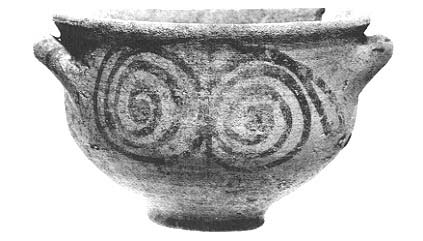
A unique Philistine temple has recently been discovered and excavated within the city limits of Tel Aviv.
The excavator, Israeli archaeologist Amihai Mazar of Hebrew University, claims it is the only excavation with a street address.
Whether or not this is true, it is the only Philistine temple site ever discovered.
The temple was found in the Philistine levels of a mound known as Tell Qasile, located on the northern bank of the Yarkon River, about a mile before it empties into the Mediterranean Sea.
The Philistine temple dates from the period of the Judges (11th century B.C.), contemporaneous with Samson and Samuel. The building is part of a small, but well-planned Philistine city of straight, parallel streets and carefully built houses.
Before this Philistine city existed, two earlier Philistine cities had been built on the same site. Indeed, the Philistines were the original settlers of the site, sometime in the 12th century, B.C. (The town history of the site had previously been revealed by excavations in the late 1940’s conducted by Professor Benjamin Mazar of Hebrew University, who is currently excavating at the Temple Mount in Jerusalem. His nephew Amihai directed the recent excavations of the Philistine temple.)
As the site was first settled by Philistines, the excavations disprove the long-held belief that the Philistines founded no cities of their own, but simply resettled cities of others. The city was probably founded here because of its proximity to the inland port on the Yarkon River—and the Philistines were a great sea-faring people.
Last summer, Amihai Mazar told the BAR, he lifted the floor of the Philistine temple he had excavated to see what lay beneath. There he found the remains of two earlier Philistine temples going back to the beginning of the settlement. However, both earlier temples were poorly preserved, unlike the last Philistine temple found in the uppermost Philistine level of the tell.
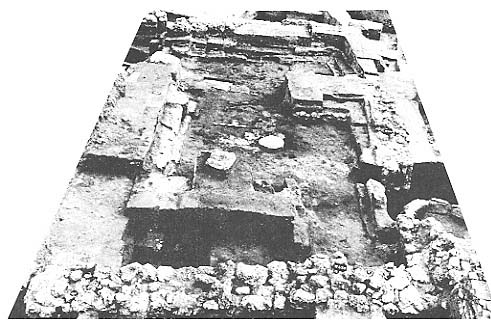
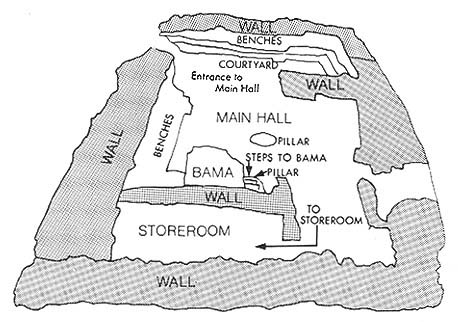
The Philistines built the walls of their last and best-preserved temple from sundried mud bricks on a stone foundation. The walls—almost 4 feet thick—have been preserved to a height of about 2–1/2 feet. The main hall of the temple is about 18 feet wide and almost 24 feet long, not much larger than a good-size living room. In front of the main hall is an antechamber about half as large as the main hall. This antechamber formed part of the temple building, adding about 12 feet to its length.
Stepped plastered benches line the walls of both rooms. At the end of the main hall is a raised platform or bama toward which worship was directed. Two steps lead up to the bama. Behind the bama wall is a narrow room in which religious objects were probably stored. The temple plan as a whole does not appear to be similar to that of any other in ancient Palestine.
Outside the temple on two sides was a wide courtyard in which a stone structure about 4 feet square was found. The archaeologists believe that since numerous animal bones were also found in the courtyard, the structure must have been the foundation of an altar for burnt animal offerings.
Philistine temples figure prominently in the Bible. After the Ark of the Lord was captured by the Philistines at the battle of Aphek-Ebenezer, it was taken to the Philistine temple of Dagon in Ashdod, one of the five cities of the Philistine pentapolis. There the ark was placed before a statue of Dagon. That night the Philistine god fell face downward before the ark; the next day Dagon was set up again. However, the next night it again fell, this time breaking its head and hands. The Bible tells us that “This is why from that day to this the priests of Dagon and all who enter the temple of Dagon at Ashdod do not set foot upon Dagon’s platform” (1 Samuel 5:5). Although there is no evidence that a statue of a god stood on the platform in the temple at Qasile, it is quite possible that this was the case.
The best known episode in the Bible involving a Philistine temple is of course the Samson story, which dates from the same period as the Philistine temple at Qasile. The tale may be found in Judges 13–16. After Delilah cut Samson’s hair as he slept, the Philistines were able to capture and imprison him. Samson’s eyes were gouged out and he was set to grinding corn. In prison, however, his hair began to grow back. Some time later, the Philistine lords assembled in Gaza for a great sacrifice to Dagon. They had the blinded Samson brought to the temple, apparently to fight before them. The sightless Israelite asked a young boy to put him where he could feel the pillars which supported the temple. Samson put his hands on the two central pillars and cried to the Lord: “Give me strength only this once, O God, and let me at one stroke be avenged on the Philistines for my two eyes” (Judges 16:28). “Then Samson leaned forward with all his might, and the temple fell on the lords and on all the people who were in it. So the dead whom he killed at his death were more than those he had killed in his life” (Judges 16:30).
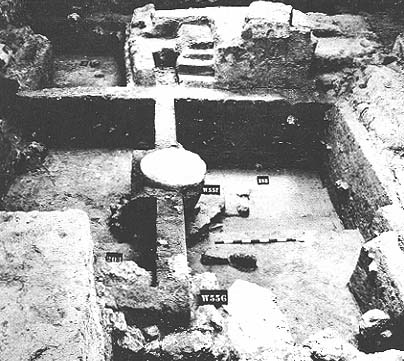
The archaeological evidence is clear that the last Philistine temple at Qasile was supported by two wooden pillars set on round, well-made stone bases placed on the central axis of the building. One of the pillars was set into the lower of the two steps leading up to the platform or bama near the end of the temple; the step was built around the pillar and on top of its stone base. The archaeologists found the imprint of the pillar clearly visible in the hole in the step. The stone base of the second pillar stands near the center of the main hall. The wall between the main hall and the antechamber provided the roof support at the other end of the main hall. The two pillars are close enough to one another as to indicate that in a similar temple the two central pillars might both be reached by a man of such unusually large proportions as Samson.
The Philistine town of Qasile was destroyed in the early 10th century B.C. King David ruled Israel from c. 1000 to 960 B.C., and it is to this Hebrew monarch that the destruction of Qasile is attributed by Professor Benjamin Mazar.
Whoever destroyed Philistine Qasile at this time also burned the temple. On the floor of the temple the excavators found brick debris, burnt wooden beams and heaps of ashes, testifying to its violent destruction.
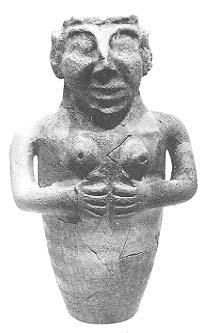
They also found some interesting cult objects and Philistine pottery on and around the raised platform or bama and in the storeroom behind it, including two cylindrical pottery standards perhaps for burning incense, a pottery plaque with two deities in relief, a bird shaped bowl perhaps for libations, and a bronze axe. From the earliest Philistine level came a vase in the shape of a woman, probably a goddess; the top of her head formed the mouth of the vase, the breasts are spouts through which libations were poured, and the arms are crossed on the body of the vase (see illustration).
The town of Qasile was re-built in the Israelite period. Apparently the Israelites found it as convenient to have a city adjacent to the Yarkon River port as did the Philistines. This town was destroyed by the Assyrians in the 8th century B.C. and was settled only sporadically thereafter.

